<< Previous | Displaying results 4801-4850 of 6769 for "" | Next >>
The defendants in the dock (right) and their lawyers (center) listen to trial proceedings during the High Command Case.
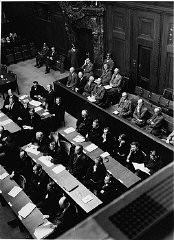
View of the main entrance to the Auschwitz camp. The sign above the gate says "Arbeit Macht Frei" (Work makes one free). Auschwitz, Poland, date uncertain.
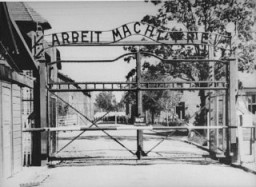
View of the kitchen barracks, the electrified fence, and the gate at the main camp of Auschwitz (Auschwitz I). In the foreground is the sign "Arbeit Macht Frei." This photograph was taken after the liberation of the camp by Soviet forces. Auschwitz, Poland, 1945.
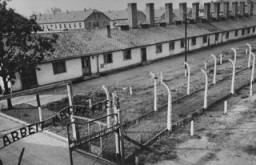
A member of the German SS supervises the boarding of Jews onto trains during a deportation action in the Krakow ghetto. Krakow, Poland, 1941–1942.
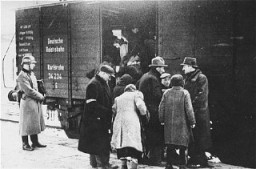
Installation of the railcar at the construction site of the United States Holocaust Memorial Museum. Washington, DC, February 9, 1991.
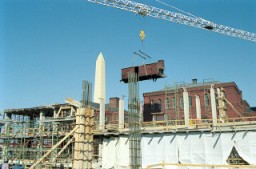
View of the railcar on display in the Permanent Exhibition of the United States Holocaust Memorial Museum. Washington DC, June 19, 1991. Courtesy of Polskie Koleje Panstwow S.A.
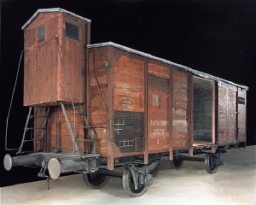
Heinrich Himmler (seated, center), chief of the SS, with Reinhard Heydrich (standing, left), chief of the Security Police and SD. Berlin, Germany, 1938.

Third meeting of the board of directors of the War Refugee Board. From the left are Secretary of State Cordell Hull, Treasury Secretary Henry Morgenthau, Secretary of War Henry Stimson, and Executive Director John Pehle. Washington, DC, United States, March 21, 1944.
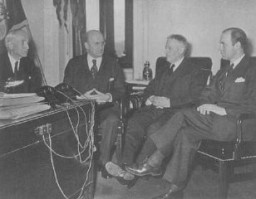
Henry Morgenthau, Jr., treasury secretary in the Roosevelt administration and later chairman of the United Jewish Appeal, greets Jewish refugees en route from Shanghai to Israel. New York, United States, March 2, 1949.

Adolf Hitler (center) with (from left to right): Heinz Riefenstahl, Frau Dr. Ebersberg, Leni Riefenstahl, Joseph Goebbels, and Ilse Riefenstahl. Germany, date uncertain.
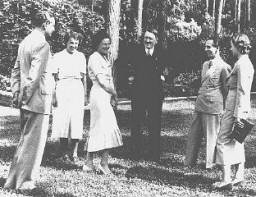
Leni Riefenstahl, with Adolf Hitler in the background, directs the shooting of a film about the Reich Party Day. Here she is shooting a segment called "Day of the Reich Work Service." Nuremberg, Germany, 1936.
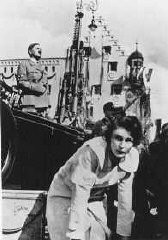
President Franklin D. Roosevelt in the Oval office at the White House, shortly before delivering a speech accepting the Democratic Party's presidential nomination. Washington, DC, United States, July 24, 1940.
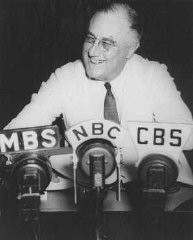
A crowd in front of the Berlin Cathedral (Berliner Dom) cheers the declaration of World War I. Berlin, Germany, August 1914. Many enthusiastically believed that World War I would be over quickly. Instead, the war became a stalemate of costly battles and trench warfare. It lasted for years and was the first great international conflict of the twentieth century. The impact of the conflict and its divisive peace would reverberate in the decades following.
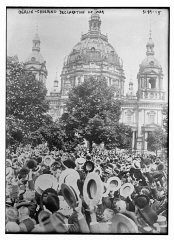
Refugees in the Gare de Lyon in Paris during World War I. Paris, France, photograph taken ca. 1914–15.
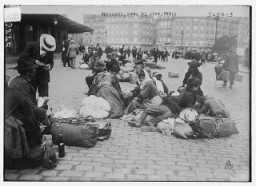
Belgian refugees in Paris during World War I, the first great international conflict of the twentieth century. Paris, France, 1914.
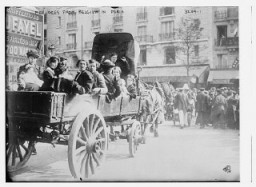
A man, women and a child sort through the rubble of a Polish home destroyed during World War I. Photograph taken ca. October 18, 1915.
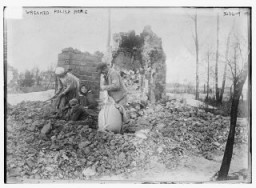
Stretcher bearers carry a wounded soldier during the Battle of the Somme in World War I. France, September 1916. IWM (Q 1332)
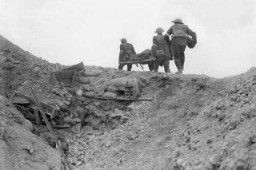
Ruins of the library in Louvain, destroyed during World War I. Louvain, Belgium, ca. 1914–1915

A French army ambulance during World War I. This photograph was taken ca. 1914–1915.
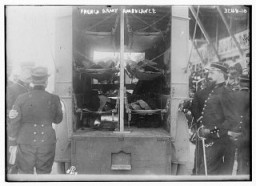
German soldiers in the Argonne Forest, France, during World War I. Photograph taken ca. 1914–1915.
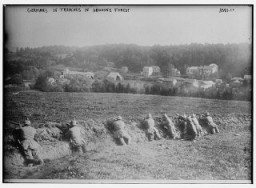
A US army field hospital inside the ruins of a church in France during World War I. France, 1918
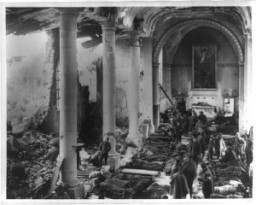
Scene of trench warfare: an abandoned British trench which was captured by German forces during World War I. German soldiers on horseback view the scene.
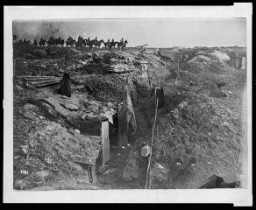
This 1919 photograph shows destruction in the leading business thoroughfare of Rheims after bombardment during World War I. Rheims, France, 1919.
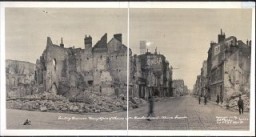
This 1919 photograph shows World War I destruction in Ypres, Belgium.
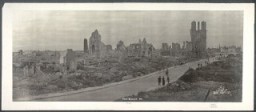
Karl Höcker's photograph album includes both documentation of official visits and ceremonies at Auschwitz as well as more personal photographs depicting the many social activities that he and other members of the Auschwitz camp staff enjoyed.
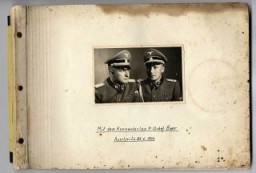
Karl Höcker (on left, looking at the camera) relaxes with SS physicians, including Dr. Fritz Klein (far left), Dr. Horst Schumann (partially obscured next to Klein, identified from other photographs), and Dr. Eduard Wirths (third from right, wearing tie). From Karl Höcker's photograph album, which includes both documentation of official visits and ceremonies at Auschwitz as well as more personal photographs depicting the many social activities that he and other members of the Auschwitz camp…
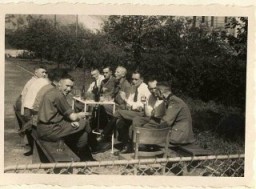
Obersturmführer Karl Höcker, June 21, 1944. Karl Höcker, adjutant to the commandant of Auschwitz, kept a photograph album. The album includes both documentation of official visits and ceremonies at Auschwitz as well as more personal photographs depicting the many social activities that he and other members of the Auschwitz camp staff enjoyed. These rare images show Nazis singing, hunting, and even trimming a Christmas tree. They provide a chilling contrast to the photographs of…
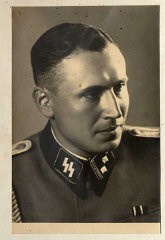
Photograph of Karl Höcker. He is standing in front of an air raid shelter. From Karl Höcker's photograph album, which includes both documentation of official visits and ceremonies at Auschwitz as well as more personal photographs depicting the many social activities that he and other members of the Auschwitz camp staff enjoyed. These rare images show Nazis singing, hunting, and even trimming a Christmas tree. They provide a chilling contrast to the photographs of thousands of Hungarian Jews…
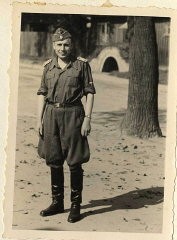
Richard Baer and Karl Höcker look over a document with SS-Standartenführer Dr. Enno Lolling, the director of the Office for Sanitation and Hygiene in the Inspectorate of Concentration Camps. From left to right: Lolling, Baer, Höcker. From Karl Höcker's photograph album, which includes both documentation of official visits and ceremonies at Auschwitz as well as more personal photographs depicting the many social activities that he and other members of the Auschwitz camp staff enjoyed.…
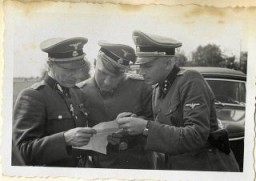
The beginning of a ceremony to dedicate a new SS hospital in Auschwitz-Birkenau. A Nazi soldier salutes as the Nazi and SS flags are raised while a line of troops stand with rifles at attention during the dedication. From Karl Höcker's photograph album, which includes both documentation of official visits and ceremonies at Auschwitz as well as more personal photographs depicting the many social activities that he and other members of the Auschwitz camp staff enjoyed. These rare images show Nazis…
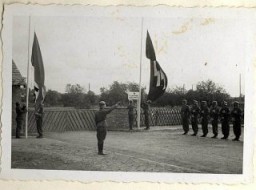
View of Solahütte, an SS retreat near Auschwitz. From Karl Höcker's photograph album, which includes both documentation of official visits and ceremonies at Auschwitz as well as more personal photographs depicting the many social activities that he and other members of the Auschwitz camp staff enjoyed. These rare images show Nazis singing, hunting, and even trimming a Christmas tree. They provide a chilling contrast to the photographs of thousands of Hungarian Jews deported to Auschwitz at the…
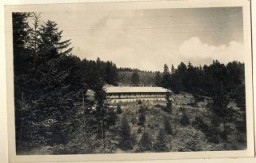
This photograph shows a group of SS officers at Solahuette, the SS retreat outside of Auschwitz. Pictured from left to right: Josef Kramer, Dr. Josef Mengele, Richard Baer, Karl Höcker, and an unidentified officer.
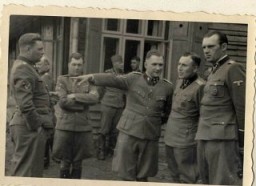
A group of SS officers socialize at an SS retreat outside Auschwitz. Pictured from left to right: Dr. Josef Mengele, Rudolf Höss, Josef Kramer, and an unidentified officer.
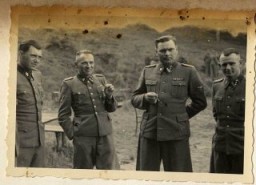
A "sing-along" during a social gathering of the SS hierarchy at Solahütte. The front row consists of (left to right): Karl Höcker, Otto Moll, Rudolf Höss, Richard Baer, Josef Kramer, Franz Hössler, and Josef Mengele. From Höcker's album.
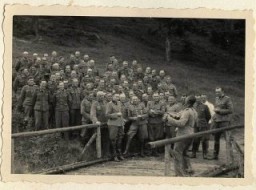
SS female auxiliaries (Helferinnen) run down a ramp in Solahütte to the music of an accordion. From Karl Höcker's photograph album, which includes both documentation of official visits and ceremonies at Auschwitz as well as more personal photographs depicting the many social activities that he and other members of the Auschwitz camp staff enjoyed. These rare images show Nazis singing, hunting, and even trimming a Christmas tree. They provide a chilling contrast to the photographs of thousands of…

SS female auxiliaries show with mock sadness that they have finished eating their blueberries, July 22, 1944. From the Hoecker Album of 116 photographs taken during the last six months of Auschwitz, between June 1944 and January 1945.
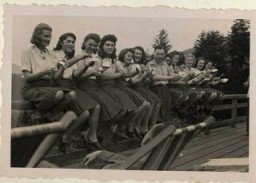
September 1, 1944, Richard Baer ceremonially accepts a copy of the construction plans from the Chief of the Central Construction Directorate of the Waffen SS, SS-Sturmbannführer Karl Bischoff, celebrating the opening of an SS military hospital (SS-Lazarette). Baer was the last commandant of the Auschwitz camp. From Karl Höcker's photograph album, which includes both documentation of official visits and ceremonies at Auschwitz as well as more personal photographs depicting the many social…
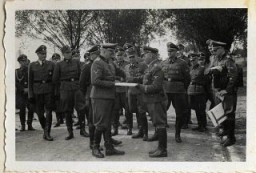
Scene during the funeral of SS officers killed in the December 26, 1944, Allied bombing of Auschwitz.
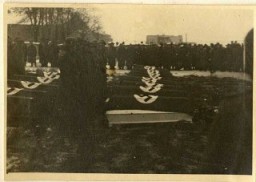
SS officer Karl Höcker salutes in front of an array of wreaths during a military funeral near Auschwitz. The original caption for the photograph reads "Beisetzung von SS Kameraden nach einem Terrorangriff." (Burying our SS comrades from a terror attack.) Pictured in the background are Josef Kramer and Karl Moeckel.This image shows the aftermath of the September 13, 1944, bombing of IG Farben in which 15 SS men died in the SS residential blocks and 28 were seriously wounded.
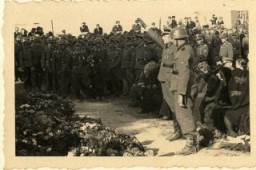
Selection of Hungarian Jews at the Auschwitz-Birkenau killing center. Poland, May 1944.
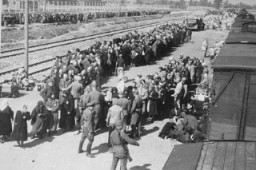
Photograph of Yisrael and Zelig Jacob, the younger brothers of Lili Jacob, from the Auschwitz Album.
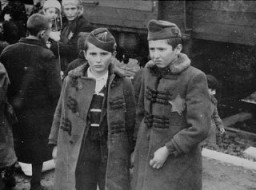
SS female auxiliaries getting off the bus on a day trip in July 1944; this image contrasts starkly with the arrival of a deported Hungarian men, women, and children in Auschwitz-Birkenau in May 1944. From Karl Höcker's photograph album, which includes both documentation of official visits and ceremonies at Auschwitz as well as more personal photographs depicting the many social activities that he and other members of the Auschwitz camp staff enjoyed. These rare images show Nazis singing, hunting, and…
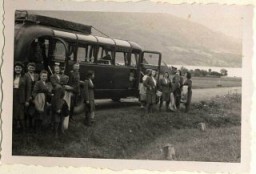
Jewish women and children deported from Hungary, separated from the men, line up for selection. Auschwitz camp, Poland, May 1944.
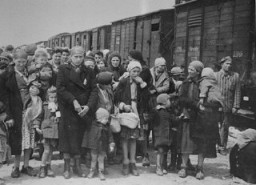

This photograph, part of the Auschwitz Album, was used as evidence in the Frankfurt trial. On the far right, you see Stefan Baretzki, a defendant in the trial, who was convicted partially because this photograph proves that he staffed the ramp.
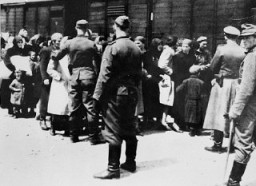
Walking to a ceremony; from left to right: Dr. Carl Clauberg, Dr. Enno Lolling, Karl Höcker (behind), Richard Baer, Dr. Eduard Wirths, Karl Bischoff (behind Wirths on the right) Rudolf Höss, and Karl Möckel.
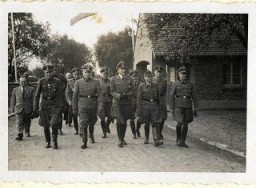
Page from Karl Höcker's album, with the caption "Yuletime, 1944." The photographs show Karl Höcker lighting the candles on the Yule tree. 1944.
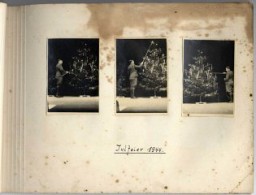
Richard Baer, Dr. Josef Mengele, and Rudolf Höss. From Karl Höcker's photograph album, which includes both documentation of official visits and ceremonies at Auschwitz as well as more personal photographs depicting the many social activities that he and other members of the Auschwitz camp staff enjoyed. These rare images show Nazis singing, hunting, and even trimming a Christmas tree. They provide a chilling contrast to the photographs of thousands of Hungarian Jews deported to Auschwitz at the same…
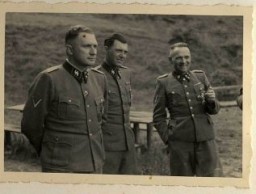
Rozalia (Krysia Laks) Lerman, Miles Lerman, and Regina Laks stand on the deck of the Marine Perch while en route to the United States. January 1947.
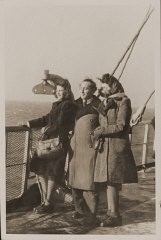
The last of the 3,000 runners who carried the Olympic torch from Greece lights the Olympic Flame in Berlin to start the 11th Summer Olympic Games. Berlin, Germany, August 1936.
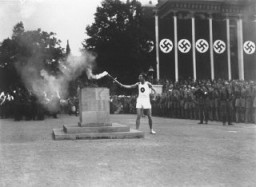
We would like to thank Crown Family Philanthropies, Abe and Ida Cooper Foundation, the Claims Conference, EVZ, and BMF for supporting the ongoing work to create content and resources for the Holocaust Encyclopedia. View the list of donor acknowledgement.